Annapolis, Maryland 作者: 来源: 发布时间:2021-11-08
I.Population and Area
₋Area
Land: 7.21 sq mi (18.67 km2)
₋Population
Total: 38,394
Density: 5,455.19/sq mi (2,106.24/km2)
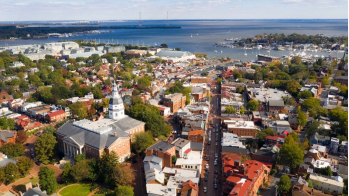
II.Natural Geography
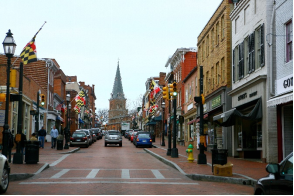
City View
₋Annapolis is the capital of the U.S. state of Maryland, as well as the county seat of Anne Arundel County. Situated on the Chesapeake Bay at the mouth of the Severn River, 25 miles (40 km) south of Baltimore and about 30 miles (50 km) east of Washington, D.C., Annapolis is part of the Baltimore–Washington metropolita n area. Its population was measured at 38,394 by the 2010 census.
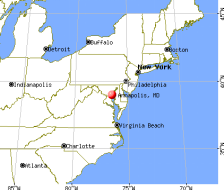
₋This city served as the seat of the Confederation Congress (former Second Continental Congress) and temporary national capital of the United States in 1783–1784. At that time, General George Washington came before the body convened in the new Maryland State House and resigned his commission as commander of the Continental Army. A month later, the Congress ratified the Treaty of Paris of 1783, ending the American Revolutionary War, with Great Britain recognizing the independence of the United States. The city and state capitol was also the site of the 1786 Annapolis Convention, which issued a call to the states to send delegates for the Constitutional Convention to be held the following year in Philadelphia. Over 220 years later, the Annapolis Peace Conference was held in 2007. Annapolis is the home of St. John's College, founded 1696; the United States Naval Academy, established 1845, is adjacent to the city limits.
III.ECONOMY
₋The average salary in Annapolis, MD is $63k. Trends in wages increased by 0.2 percent in Q1 2020. The cost of living in Annapolis, MD is 43 percent higher than the national average. The most popular occupations in Annapolis, MD are Software Engineer, Office Manager, and Executive Assistant which pay between $39k and $117k per year. The most popular employers in Annapolis, MD are Anne Arundel Medical Center, Rockwell Collins, Inc., and Northrop Grumman Corporation.
₋Website: https://www.payscale.com/research/US/Location=Annapolis-MD/Salary
IV.Industrial Characteristics
₋Ideal Location
The area’s diverse industry base of maritime, cybersecurity, advanced technology, professional and business services, and tourism is a stable generator of job creation and business opportunities. Situated as the eastern anchor of Anne Arundel County, Annapolis’ proximity to Washington DC, Baltimore MD, and transportation assets provides an ideal business location. While proximity to these metropolitan areas is a benefit to businesses and residents alike, Annapolis is just distant enough to maintain a small town atmosphere with a vibrant historic downtown, walkable streets and neighborhoods, and a collaborative business environment.
₋Fertile Ground
Culture and environment have strongly influenced the development of industry in Annapolis. From the creation of the nation’s first theater to the founding of numerous tech companies, our community remains at the forefront of innovation and creativity. Creative professionals naturally gravitate to the area, fostering an economy focused on technological innovation, artistic expression, artisanal foods, and hand-crafted goods. The ecological wonders of the Chesapeake Bay have provided fertile ground for the development of our leading water sports, tourism, and marine businesses. Our extraordinary lifestyle is ideal for your business and workforce.
₋Distinctly Different
Annapolis has created a market that is distinctly different from nearby Baltimore MD and Washington DC. The natural features and small-town appeal encourage a boutique market for entrepreneurs and business owners who seek a high quality lifestyle that really has it all, a community eager to support local businesses, and a constant talent pool that flows down from the wide range of Maryland’s renowned educational, research and military institutions.
₋Website: https://www.aaedc.org/city-of-annapolis/our-industries/
V.Attractions
1. Maryland State House
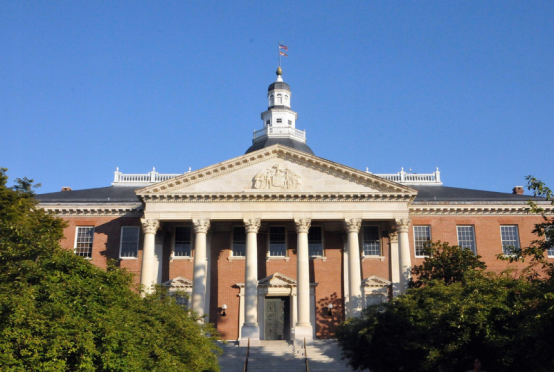
₋The Maryland State House is located in Annapolis, Maryland as the oldest U.S. state capitol in continuous legislative use, dating to 1772 and housing the Maryland General Assembly, plus the offices of the Governor and Lieutenant Governor. In 1783 and 1784 it served as the capitol building of the United States Congress of the Confederation, and is where Ratification Day, the formal end of the American Revolutionary War, occurred.
₋The capitol has the distinction of being topped by the largest wooden dome in the United States constructed without nails. The current building, which was designated a National Historic Landmark in 1960, is the third statehouse on its site. The building is administered by the State House Trust, established in 1969.
₋Construction began in 1772, but was not completed until 1797 due to the ongoing American Revolutionary War. The two-story brick Georgian style structure, located inside State Circle, was designed by architect Joseph Horatio Anderson. A small portico juts out from the center of the building, topped by a pediment, with two high arched windows framing the entrance. On both floors, large rectangular windows line the facade. A cornice is topped by another pediment and the sloping roof gives way for a central octagonal drum atop which rests a dome. The large dome is topped by a balustraded balcony, another octagonal drum and a lantern capped by a lightning rod. The rod was constructed and grounded according to the direct specifications of its inventor, Benjamin Franklin.
₋The building was surrounded by a low brick wall in 1818 to prevent cattle incursions. This was replaced by an iron fence with a granite base in 1836. The dome of the statehouse is depicted on the Maryland state quarter.
₋An annex to the State House was constructed between 1902 and 1906 under the supervision of Baltimore architects Baldwin & Pennington; the new annex replaced earlier 19th-century annexes. The current state House of Delegates and Senate chambers are part of the annex, which is clad in black and gold Italian marble. The annex includes the Grand Staircase from the first to the second floors; above the staircase is the painting Washington Resigning His Commission by Edwin White, executed in 1858. In 2017, two additional paintings, both from the collection of the Enoch Pratt Free Library—were hung above the staircase. These additions were a portrait of Charles Calvert, 5th Baron Baltimore by Allan Ramsay (c. 1740) and a portrait of Frederick Calvert, 6th Baron Baltimore by Johann Ludwig Tietz (c. 1750).
₋In the mid-1990s, the cypress dome underwent a structural renovation and repainting. However, the latex paint that was used failed to bond due to preceding layers, causing it to flake. In 2011, the old paint was removed and replaced with white oil-based paint.
₋Address: 100 State Cir, Annapolis, MD 21401, United States
₋Website: https://msa.maryland.gov/msa/mdstatehouse/html/home.html
2. William Paca House
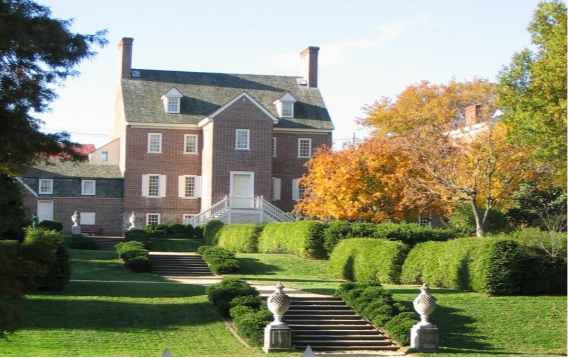
₋The William Paca House (at one time known as Carvel Hall) is an 18th-century Georgian mansion in Annapolis, Maryland, United States. William Paca was a signatory of the Declaration of Independence and a three-term Governor of Maryland. The house was built between 1763 and 1765 and its architecture was largely designed by Paca himself. The 2-acre (8,100 m2) walled garden, which includes a two-story summer house, has been restored to its original state.
₋The William Paca House and Garden was declared a National Historic Landmark in 1971.
₋The original one-story office and kitchen pavilions, and their connecting hyphens, were altered in the 19th century with the house's conversion to a hotel, by a second story added to the hyphens and the west wing. These changes have since been reversed, and the building approximates its original outward appearance, both inside and out.
₋The Paca House is a Georgian five-part house. The brick structure comprises a central 2-1/2 story block on an elevated basement, flanked by symmetrical 1-1/2 story end pavilions, connected to the central structure by 1-1/2 story hyphens. The interior is a center hall plan with two rooms on either side of the hall. Original woodwork remains only in the central hall, stair hall and the west parlor, including the stair's original Chinese Chippendale balustrade.
₋Address: 186 Prince George St, Annapolis, MD 21401, United States
₋Opened: 1763
₋Phone: +1 410-990-4543
₋Website: https://www.annapolis.org/contact/william-paca-house-garden
3.United States Naval Academy Museum
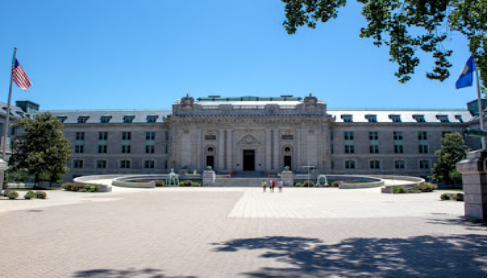
₋The United States Naval Academy Museum is a public maritime museum in Annapolis, Maryland, United States. A part of the United States Naval Academy, it is located at Preble Hall within the Academy premises. The museum has an area of 12,000 square feet (1,100 m2) with four galleries. The museum is open seven days a week, from 9 am to 5 pm on Mondays through Saturdays, and 11 am to 5 pm on Sundays; it is only closed on Thanksgiving Day, Christmas Day, and New Year's Day. It is currently headed by Director CDR Claude Berube, PhD USNR.
₋The museum's history dates back to 1845, when it was founded as the Naval School Lyceum. In 1849, President James K. Polk directed the Navy's collection of historic flags be sent to the new Naval School at Annapolis for care and display, establishing one of the museum's oldest collections. After the Civil War, the Navy Department began forwarding many types of objects to the Naval Academy Lyceum, including trophies of war, items from exploration/survey expeditions, diplomatic missions, and naval related art. The Lyceum also became the repository for the collections of the U. S. Naval Lyceum at the New York Navy Yard in 1892, and received an extensive collection from the Boston Naval Library and Institute in 1922, significantly growing the collection.
₋The Naval Academy Lyceum of the 19th and early 20th centuries was located in several places around the Naval Academy Yard, before the construction of Preble Hall in 1939. From 2007–2008, Preble Hall underwent a complete renovation to turn the building into a modern museum, which officially reopened in the summer of 2009.
₋Address: 118 Maryland Ave, Annapolis, MD 21402, United States
₋Phone: +1 410-293-2108
₋Website: https://www.usna.edu/Museum/index.php
VI.History
₋Colonial and early United States (1649–1808)
₋A settlement in the Province of Maryland named "Providence" was founded on the north shore of the Severn River on the middle Western Shore of the Chesapeake Bay in 1649 by Puritan exiles from the Province/Dominion of Virginia led by third Proprietary Governor William Stone (1603–1660). The settlers later moved to a better-protected harbor on the south shore. The settlement on the south shore was initially named "Town at Proctor's," then "Town at the Severn," and later "Anne Arundel's Towne" (after Lady Ann Arundell (1616–1649), the wife of Cecilus Calvert, second Lord Baltimore, who died soon afterwards).
₋In 1654, after the Third English Civil War, Parliamentary forces assumed control of the Maryland colony and Stone went into exile further south across the Potomac River in Virginia. Per orders from Charles Calvert, fifth Lord Baltimore, Stone returned the following spring at the head of a Cavalier royalist force, loyal to the King of England. On March 25, 1655, in what is known as the Battle of the Severn (first colonial naval battle in North America), Stone was defeated, taken prisoner, and replaced by Lt. Gen. Josias Fendall (1628–1687) as fifth Proprietary Governor. Fendall governed Maryland during the latter half of the Commonwealth period in England. In 1660, he was replaced by Phillip Calvert (1626–1682) as fifth/sixth Governor of Maryland, after the restoration of Charles II (1630–1685) as King in England.
₋In 1694, soon after the overthrow of the Catholic government of second Royal Governor Thomas Lawrence (1645–1714), then third Royal Governor Francis Nicholson (1655-1727/28, served 1694–1698), moved the capital of the royal colony, the Province of Maryland, to Anne Arundel's Towne and renamed the town Annapolis after Princess Anne of Denmark and Norway, soon to be the Queen Anne of Great Britain (1665–1714, reigned 1702–1714). Annapolis was incorporated as a city in 1708.[8] Colonel John Seymour, the Governor of Maryland wrote Queen Anne on March 16, 1709, with qualifications for municipal officials and provisions for fairs and market days for the town.
₋17th-century Annapolis was little more than a village, but it grew rapidly for most of the 18th century until the American Revolutionary War as a political and administrative capital, a port of entry, and a major center of the Atlantic slave trade. The Maryland Gazette, which became an important weekly journal, was founded there by Jonas Green in 1745; in 1769 a theatre was opened; during this period also the commerce was considerable, but declined rapidly after Baltimore, with its deeper harbor, was made a port of entry in 1780. Water trades such as oyster-packing, boatbuilding and sailmaking became the city's chief industries. Annapolis is home to a large number of recreational boats that have largely replaced the seafood industry in the city.
₋Dr. Alexander Hamilton (1712–1756) was a Scottish-born doctor and writer who lived and worked in Annapolis. Leo Lemay says his 1744 travel diary Gentleman's Progress: The Itinerarium of Dr. Alexander Hamilton is "the best single portrait of men and manners, of rural and urban life, of the wide range of society and scenery in colonial America."
₋Annapolis became the temporary capital of the United States after the signing of the Treaty of Paris in 1783. Congress was in session in the state house from November 26, 1783, to June 3, 1784, and it was in Annapolis on December 23, 1783, that General Washington resigned his commission as commander-in-chief of the Continental Army.
₋For the 1783 Congress, the Governor of Maryland commissioned John Shaw, a local cabinet maker, to create an American flag. The flag is slightly different from other designs of the time. The blue field extends over the entire height of the hoist. Shaw created two versions of the flag: one which started with a red stripe and another that started with a white one.
₋In 1786, delegates from all states of the Union were invited to meet in Annapolis to consider measures for the better regulation of commerce. Delegates from only five states—New York, Pennsylvania, Virginia, New Jersey, and Delaware—actually attended the convention, known afterward as the "Annapolis Convention." Without proceeding to the business for which they had met, the delegates passed a resolution calling for another convention to meet at Philadelphia in the following year to amend the Articles of Confederation. The Philadelphia convention drafted and approved the Constitution of the United States, which is still in force.
₋Civil War era (1849 – late 1800s)
₋On April 24, 1861, the midshipmen of the Naval Academy relocated their base in Annapolis and were temporarily housed in Newport, Rhode Island, until October 1865.
₋In 1861, the first of three camps that were built for holding paroled soldiers was created on the campus of St. John's College. The second location of Camp Parole would house over 20,000 and would be located where Forest Drive is currently. The third and final location was finished in late 1863 and would be placed near the Elkridge Railroad, as to make transportation of soldiers and resources easier before and allowing the camp to grow to its highest numbers. This area just west of the city is still referred to as Parole. The soldiers who did not survive were buried in the Annapolis National Cemetery.
₋Contemporary era
₋In 1900, Annapolis had a population of 8,585.
₋On December 21, 1906, Henry Davis was lynched in the city. He was suspected of assaulting a local woman. Nobody was ever tried for the crime.
₋During World War II, shipyards in Annapolis built a number of PT Boats, and military vessels such as minesweepers and patrol boats were built in Annapolis during the Korean and Vietnam wars. It was at Annapolis in July 1940 that Grand Duchess Charlotte of Luxembourg arrived in exile during World War II.
₋In the summer of 1984, the Navy Marine Corps Memorial Stadium in Annapolis hosted soccer games as part of the XXIII Olympiad.
₋During September 18–19, 2003, Hurricane Isabel created the largest storm surge known in Annapolis's history, cresting at 7.58 feet (2.31 m). Much of downtown Annapolis was flooded and many businesses and homes in outlying areas were damaged. The previous record was 6.35 feet (1.94 m) during a hurricane in 1933, and 5.5 feet (1.7 m) during Hurricane Hazel in 1954. Downtown Annapolis has high-tide "sunny day" flooding. A Stanford University study found that this resulted in 3,000 less visits and $172,000 in lost revenue for local business in 2017.
₋From mid-2007 through December 2008, the city celebrated the 300th anniversary of its 1708 Royal Charter, which established democratic self-governance. The many cultural events of this celebration were organized by Annapolis Charter 300.
₋Annapolis was home of the Anne Arundel County Battle of the Bands, which was held at Maryland Hall from 1999–2015. The event was a competition between musical groups from each high school in the county; it raised over $100,000 for the county's high school music programs during its 17-year run.
₋On June 28, 2018, at the Capital Gazette, a gunman opened fire, killing five journalists and injuring two more. The perpetrator of the shooting was Jarrod Ramos.
₋The State House
₋The Maryland State House is the oldest in continuous legislative use in the United States. Construction started in 1772, and the Maryland legislature first met there in 1779. It is topped by the largest wooden dome built without nails in the country. The Maryland State House housed the workings of the United States government from November 26, 1783, to August 13, 1784, and the Treaty of Paris was ratified there on January 14, 1784, so Annapolis became the first peacetime capital of the U.S.
₋It was in the Maryland State House that George Washington famously resigned his commission before the Continental Congress on December 23, 1783.
₋United States Naval Academy
₋The United States Naval Academy was founded in 1845 on the site of Fort Severn, and now occupies an area of land reclaimed from the Severn River next to the Chesapeake Bay. The Annapolis area was the home of a VLF-transmitter called NSS Annapolis, which was used by the United States Navy to communicate with its Atlantic submarine fleet. Students that attend the Naval Academy are enrolled in school for four years with a following five year commitment to serving in the Marine Corps or Navy. There is a typical average of around 4,500 students enrolled.
₋St. John's College
₋St. John's College is a non-sectarian private college that was once supported by the state. It was opened in 1789 as the successor of King William's School, which was founded by an act of the Maryland legislature in 1696 and was opened in 1701. Its principal building, McDowell Hall, was originally to be the governor's mansion; although £4,000 was appropriated to build it in 1742, it was not completed until after the War of Independence.
VII.Other Information
₋Roads and highways
₋No major highways enter the city limits of Annapolis. However, just outside the city limits, Interstate 595/U.S. Route 50/U.S. Route 301 traverses the region on an east–west route, connecting the Annapolis area to Washington, D.C., and the Eastern Shore of Maryland. Interstate 97 interchanges with I-595/US 50/US 301 a few miles west of Annapolis and provides the most direct link to Baltimore. Maryland Route 2 also passes just outside the city limits and is the best connection to Southern Maryland, while also providing an alternate route to Baltimore.
₋The most prominent roads directly accessing the city include Maryland Route 70, which connects downtown Annapolis to I-595/US 50/US 301, and Maryland Route 665, which does likewise for the southwestern portions of the city. Other state highways serving Annapolis include Maryland Route 181, Maryland Route 387, Maryland Route 393, Maryland Route 435, Maryland Route 436, Maryland Route 450, Maryland Route 788 and Maryland Route 797.
₋Bus
₋The Annapolis Department of Transportation (ADOT) provides bus service with eight routes, collectively branded Annapolis Transit. The system serves the city with recreational areas, shopping centers, educational and medical facilities, and employment hubs. ADOT also offers transportation for the elderly and persons with disabilities. Several Maryland Transit Administration commuter buses also allow for access to Baltimore or Washington, D.C.
₋Railway
₋Annapolis is the only capital city in America east of the Mississippi River without rail transport of any sort. From 1840 to 1968, Annapolis was connected to the outside world by railroad. The Washington, Baltimore and Annapolis Railroad (WB&A) operated two electrified interurban lines that brought passengers into the city from both the South and the North. The southern route ran down King George Street and Main Street, leading directly to the statehouse, while the northern route entered town via Glen Burnie. In 1935, the WB&A went bankrupt due to the effects of the Great Depression and suspended service along its southern route, while the newly created Baltimore and Annapolis Railroad (B&A) retained service on the northern route. Steam trains of the Baltimore and Ohio Railroad also occasionally operated over the line to Annapolis, primarily for special Naval Academy movements. Passenger rail service on the B&A was eventually discontinued in 1950; freight service ceased in 1968 after the dilapidated trestle crossing the Severn River was condemned. The tracks were eventually dismantled in 1976.
VIII.Contact Information
Government
Type: Mayor–council
Body: Annapolis City Council
Mayor: Gavin Buckley (D)
City Hall
Physical Address:View Map
160 Duke of Gloucester Street
Annapolis, MD 21401
Mailing Address:
160 Duke of Gloucester
Annapolis, MD 21401
Phone:
410-263-7942
Website: https://www.annapolis.gov/Directory.aspx?DID=33
